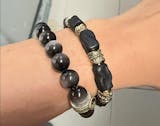Why Young People Are Embracing Silver Jewelry?
Introduction
In recent years, a shimmering trend has emerged in the world of fashion and accessories: the rise of silver jewelry among young people. This shift from gold to silver is more than just a passing fad; it's a reflection of changing values, economic realities, and aesthetic preferences. Let's delve into the reasons behind this silver revolution and what it means for the future of jewelry.

The Allure of Affordability in an Uncertain Economy
One of the primary drivers behind the popularity of silver jewelry among young people is its affordability. In an era of economic uncertainty, rising living costs, and stagnant wages, silver offers a way for young consumers to indulge in luxury without breaking the bank.The World Gold Council's 2020 survey revealed that only 11% of Gen-Z consumers planned to buy gold jewelry within the next year.
This statistic speaks volumes about the changing priorities of younger generations. Silver, being significantly less expensive than gold, allows young people to experiment with different styles and build extensive collections without feeling guilty about the expense.Moreover, the affordability of silver aligns with the growing trend of conscious consumerism among younger generations. They can invest in quality pieces that look luxurious without contributing to excessive consumption or financial strain.

Versatility and Contemporary Design
Silver's versatility is another key factor in its appeal to young consumers. Unlike gold, which often carries connotations of traditional or formal wear, silver effortlessly transitions from day to night, casual to formal. This adaptability resonates with the dynamic lifestyles of young people who value flexibility in their fashion choices.
Jenny Bird, a prominent jewelry designer, points out that "the minimalist and voluminous high-shine shapes in jewelry that are also trending right now just really suit silver." This observation highlights how silver complements contemporary design trends, offering a modern and edgy aesthetic that appeals to younger tastes.The experimental nature of current silver jewelry designs also plays a significant role. As Bird notes, "Silver is now starring in a high fashion role as the finish on art-gallery-worthy pieces that are just as much mini sculptures as they are earrings." This artistic approach to jewelry design speaks to young people's desire for unique, expressive pieces that reflect their individuality.

Cultural Shift and Redefinition of Luxury
The preference for silver among young people also signifies a broader cultural shift in how luxury and status are perceived. While previous generations might have equated precious metals with gold, younger consumers are redefining what constitutes valuable jewelry.This shift is partly driven by a move away from ostentatious displays of wealth.
Silver jewelry, with its understated elegance, allows young people to accessorize stylishly without appearing flashy or overly materialistic. It aligns with a growing preference for minimalism and authenticity in personal style.Furthermore, the rise of silver jewelry coincides with a generational rejection of traditional markers of success and status. Young people are increasingly valuing experiences over possessions, and when they do invest in material items, they prioritize uniqueness and personal meaning over conventional symbols of wealth.

Sustainability and Ethical Considerations
The preference for silver jewelry among young consumers also ties into growing concerns about sustainability and ethical production in the fashion industry. Silver mining and production generally have a lower environmental impact compared to gold, aligning with the eco-conscious values of many young consumers.Additionally, the lower cost of silver makes it easier for small, independent jewelers to work with, fostering a market for handmade, locally produced jewelry. This appeals to young consumers who are increasingly interested in supporting small businesses and artisans rather than large corporations.
The Influence of Social Media and Celebrity Culture
Social media platforms have played a crucial role in popularizing silver jewelry among young people. Influencers and celebrities showcasing silver pieces have helped drive the trend, making it more desirable to younger audiences.The visual nature of platforms like Instagram and TikTok has also contributed to the popularity of silver jewelry. Silver photographs well, often appearing more striking and eye-catching in digital images than gold. This photogenic quality makes silver jewelry ideal for social media content, further fueling its popularity among young, digitally-native consumers.

Conclusion
The preference for silver jewelry among young people is more than just a trend; it's a reflection of changing values, economic realities, and aesthetic preferences. As silver continues to shine in the spotlight, it's clear that this metal is not just a substitute for gold, but a distinct choice that resonates with the sensibilities of younger generations. Whether driven by affordability, versatility, or a shift in cultural perceptions of luxury, silver jewelry has firmly established itself as the metal of choice for the youth of today.
Related articles:
What is Sterling Silver and How to Spot Genuine Jewelry?
Top 10 Benefits of Wearing Stunning Sterling Silver Jewelry
Golden Jewelry vs. Silver Jewelry: A Comprehensive Comparison
Why Silver Jewelry Features Dragon Imagery: Unveiling Its Cultural Significance

























































